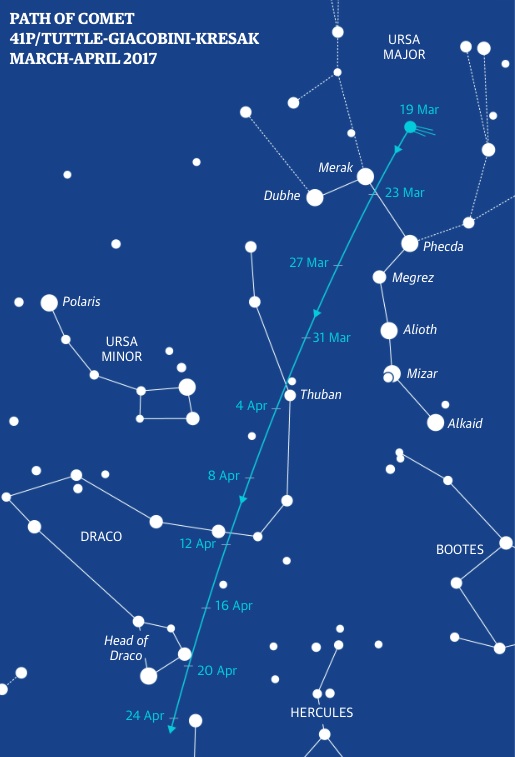With a week to go until the spring equinox in Earth’s northern hemisphere, the brilliant Venus is poised to plummet into our western evening twilight on its way to passing 8° N of the Sun’s near side on the 25th. Meanwhile Jupiter rises in the E in mid-evening and is prominent in the S in the small hours where it stands below-left of the Moon on the 14th and alongside the Moon on the 15th.
As the largest planet, Jupiter’s gravity must have helped to shape the orbits of the other planets and asteroids. One influence was to cause the tilt of most of the planetary orbits to align more closely with that of Jupiter than with the Sun’s equator, as might have been expected.
Comets, too, come under Jupiter’s spell. It is thought that most originate in the farthest reaches of the solar system, but if they stray Sun-wards into the realm of the known planets, some may be gravitationally captured into tighter, shorter-period orbits. More than 300 well-observed comets are classed as members of the Jupiter family of comets, which show every sign of having been captured by Jupiter into low-tilt orbits with periods of less than 20 years.
One Jupiter-family comet was the target of Europe’s highly successful Rosetta mission, 67P/Churyumov–Gerasimenko. This traces a 6.4-years orbit from just beyond Jupiter’s distance to almost as far in as the Earth. Another is comet 41P/Tuttle–Giacobini–Kresák which orbits every 5.4 years from a little inside the Jovian path to within 7m km of the Earth’s orbit.
The icy nucleus of comet 41P may be only 1.4km wide, smaller even then the “head” of 67P’s famous rubber duck. It is also inconveniently dim – Horace Tuttlewas first to spot it in 1858 but it wasn’t until it was rediscovered by Michel Giacobini in 1907 and Ľubor Kresák in 1951 that its orbit was pinned down.
It is now our turn, for it passes only 21m km from Earth on 1 April as it nears perihelion on the 12th. Our chart looks to the NNE at about 21:00 GMT at present and shows the path of Comet 41P from the 19th as it sweeps through the Plough, or Big Dipper. Ticks along the track mark its positions at midnight.
Catch 41P 1.9° below Merak late on the 22nd and only 0.6° to the left of Thuban in Draco late on 3 April, but don’t expect to see a wondrous tailed comet. Rather, binoculars may show it as a small greenish blob near the 7th magnitude – difficult if you must contend with light pollution. However, on past form there may be outbursts near perihelion that can make it up to three magnitudes brighter for a few days at a time, so it could become a naked-eye object.

